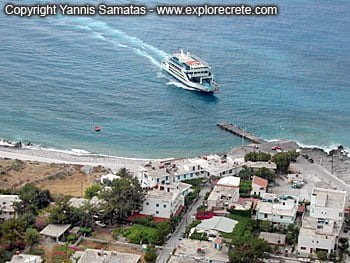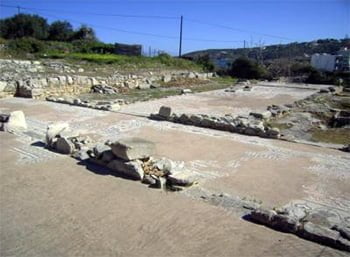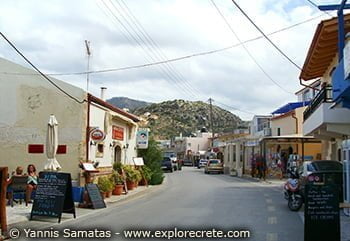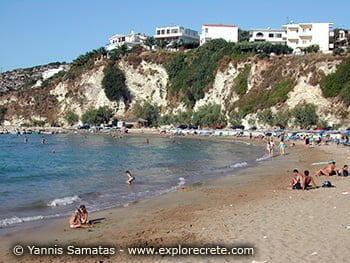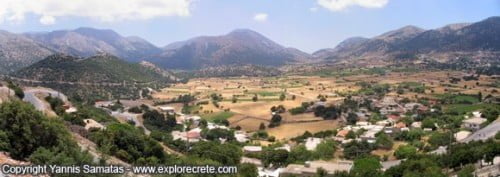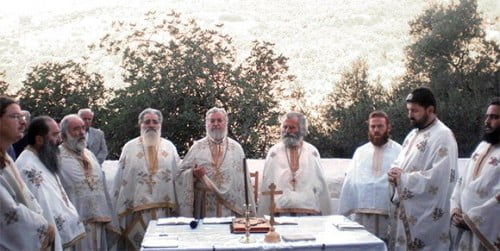Monastery of Agia Triada Tzagarolon
The Monastery of Agia Triada (Holy Trinity), or Tzagarolon Monastery as it is also known, is one of the most impressive monasteries you will see in Crete.

The Monastery of Agia Triada is located on the Akrotiri Peninsula, in the north of Chania Prefecture. It is 15 kilometres from Chania, very close to Chania Airport and the equally – famous Monastery of Gouverneto.
The Monastery of Agia Triada has a distinctive façade with Doric columns, but the elements of Renaissance architecture remind us that the monastery was built by the Cretan monks Ieremias and Lavrentios, of the Venetian Orthodox Tzagarolos family.
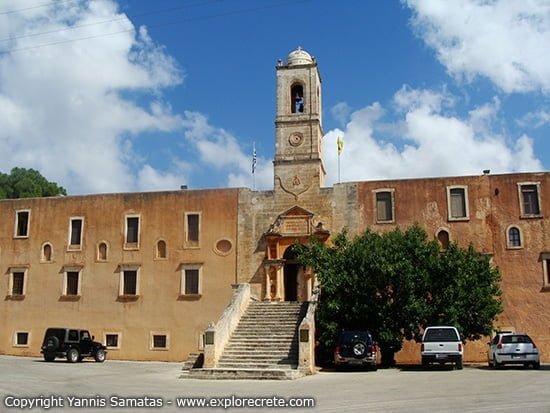
Tzagarolon Monastery is a Patriarchal – Stavropegiac monastery. It is now one of the most important monasteries in Crete, with huge influence on education in the island.
A Stavropegiac or Patriarchal monastery is one which is directly under the control of the Ecumenical Patriarch rather than the local bishop or metropolitan. By Orthodox Church tradition, the Patriarch has the right, when a monastery is founded in his jurisdiction, to send a cross which is placed in the foundations and establishes its direct dependence on him.
The Monastery of Agia Triada is not only very important but also extremely beautiful, so it is really well worth visiting if you are in Chania Prefecture, combining your visit with Gouverneto Monastery just a few kilometres away.
Opening hours
Monastery of Agia Triada opening hours: 8 a.m. to sunset
Winter :8 a.m. to 2 p.m. and 4 p.m. to sunset
Please make sure you are decently dressed when visiting the monastery.
How to get to the Monastery of Agia Triada
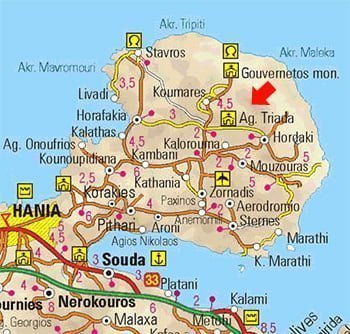
If you are coming from Chania (15 km from the monastery), take the road to the tombs of the Venizelos Family and the area of Kounoupidiana. At the crossroads to Kounoupidiana, turn right to villageKambani.
The road is mostly very good and there are several signposts to the monastery. The scenery is lovely, and the final stretch of straight road leading to the monastery is impressively lined with cypresses, allowing you to see the imposing façade of the monastery only at the end of the road.
From Rethymno, Heraklion and other cities east of the Monastery of Agia Triada.
From Rethymno, Heraklion and other cities east of the Monastery of Agia Triada.
History of the Monastery of Agia Triada
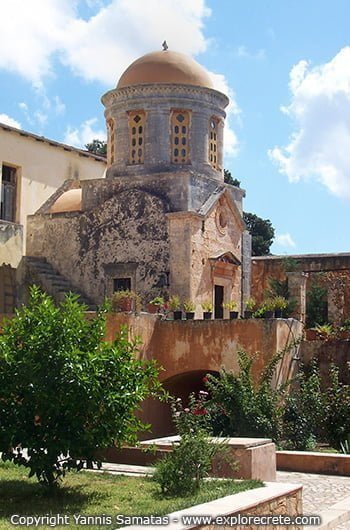
The Monastery of Agia Triada Tzagarolon was built in 1634, on the site of a small church dedicated to the Holy Apostles.
The monks Lavrentios and Ieremias who built the monastery came from the great Venetocretan Tzagarolos family, which is reported to have exercised great influence on the local Orthodox and Catholic communities.
The two brother monks were highly educated, learned in history, Greek and Latin, and also architecture. In fact it was Ieremias who designed and built the church, influenced by the great 16th-century Veronese architect Sebastiano Serlio.
Ieremias undertook the design and building of the new church in 1611, as the existing church was small and abandoned. Ieremias did indeed begin work on the monastery but died before it was completed, so his brother Lavrentios continued his labours.
In 1645, when the Turks invaded Crete, work on Tzagarolon Monastery was interrupted. The Turks called the monastery Selvili Manastir, which means “Monastery of the Cypresses” – presumably because of the cypress drive leading to the monastery.
Later, at the Greek Revolution in 1821, the monks living in the monastery managed to escape, but were forced to leave behind all the historical relics and manuscripts they had collected, which were burnt by the Turks.
After the end of the Greek Revolution, the Monastery of Agia Triada was re-established and the building work completed. In the meantime, the monastery had acquired a large fortune and extended its activity to Asia Minor.
The Monastery of Agia Triada Tzagarolon today
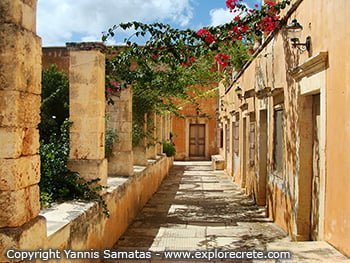
The Monastery of Agia Triada Tzagarolon continues to play an important role in the ecclesiastical life of Crete and the local economy, while it is also one of the major historical monuments of the island.
The monastery supports schools in Chania, and a seminary has operated within the monastery itself since 1892.
It is worth visiting the monastery church and complex and wander round the area for a while. Don’t miss the large exhibition of woodcarvings and icons in the monastery Museum.
The collection is impressive and makes you wonder about the number and value of the much older relics which were destroyed by the Turks during the 1821 Revolution.
Architecture of the Monastery of Agia Triada
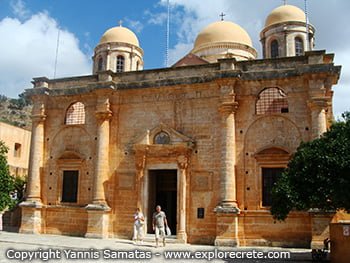
Tzagarolon Monastery is a square building complex with the monastery church standing in the centre of the verdant courtyard.
As soon as you enter the gate, you will see the wells and stairs adorned with bougainvillea, oleander and other seasonal flowers, adding a lovely accent to the complex. This may be one of the few Cretan monasteries where the inner courtyard is so beautiful and well cared for.
The west wing of the monastery is a three-storey building and includes vaulted storerooms where the wine and olive oil were once kept, while most of the courtyard is taken up by a large cistern which was used to collect rainwater from the surrounding buildings.
Inside the complex there was an olive press and a cellar for the wine produced by the monastery, while on the south side is the monastery library, formerly the Abbot’s Room.
The church of Agia Triada (Holy Trinity)
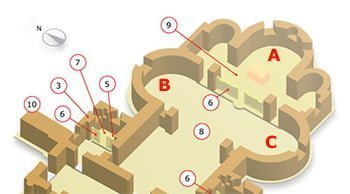
The monastery church, which stands out as soon as you climb the stairs and pass through the great gate, is made of dressed stone in the Venetian style.
The church of Agia Triada (Holy Trinity) is a domed triconch church (see photo for the three conches, or semicircular apses, Α, Β, C –>), an architectural type originating with the monasteries of Mount Athos.
The church was completed after the Greek Revolution of 1821, once the Turkish authorities had given permission for the domes to be built in 1830.
Of the original decoration of the church, only the icon screen in the ground-floor chapel remains. The gilded icon screen is beautiful and reveals the skill of the artist who made it, even so many centuries later.
Cretan folk tradition and the Baroque style followed on the island for a long period are evident in the decoration of both church and icon screen. The icons of the latter are attributed to the artist Mercourios from Santorini.
Even if you are not into religious tourism, the Monastery of Agia Triada Tzagarolon is well worth a visit. It is a lovely, peaceful and impressive place, something different for visitors to Crete who want to see the historical monuments of the island.
Organic wine and olive oil from Tzagarolon Monastery
In recent years the Monastery of Agia Triada Tzagarolon has developed the systematic cultivation of organic vines and olives, and produces excellent wine, tsikoudia (raki), olive oil, honey, vinegar and olive oil soap.
The monastery produces 20 tonnes of organic virgin olive oil per year. It has won international prizes and is mainly sold abroad.
The following wines are produced: dry red Cabernet, dry red Fokiano Romeiko, dry red Merlot, dry white Trebiano
Naturally all the products of Agia Triada are available for sale from the monastery shop.

© explorecrete.com All Rights Reserved. Reproduction or copying without permission is prohibited.

